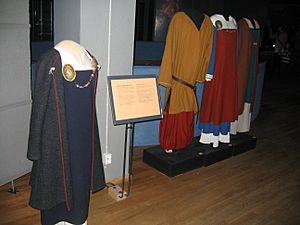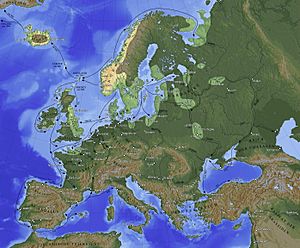Norsemen facts for kids
The Norsemen were a group of people from Scandinavia in the Early Middle Ages. They spoke a language called Old Norse, which is the ancestor of languages spoken today in countries like Norway, Sweden, Denmark, and Iceland.
Around the late 700s, these Scandinavians started traveling far and wide. This period is known as the Viking Age. In English, these brave traders, settlers, and warriors are often called Vikings. Historians sometimes talk about two main groups: Norse Vikings from Norway, who mostly explored and settled in places like Ireland and the islands north and west of Britain; and Danish Vikings, who mainly went to eastern Britain.
Today, the descendants of the Norsemen are the people of Denmark, Iceland, the Faroe Islands, Norway, and Sweden. They are usually called 'Scandinavians' instead of Norsemen.
Contents
What Does "Norseman" Mean?
The word Norseman became popular in English in the early 1800s. It comes from an older word, norse, which meant 'Norwegian' or 'from Scandinavia'.
People in the Middle Ages often called the Norse-speaking people 'Northmen'. For example, the Old Frankish word Nortmann (meaning "Northman") was used in Latin texts as Normannus. This Latin word then became Normands in Old French. This is where the name for the Normans and the region of Normandy in France comes from. Norsemen settled in Normandy in the 900s.
The Anglo-Saxon Chronicle, an old English record, even separated the Norwegian Norsemen from Dublin and the Christian Danes from an area called the Danelaw. In 942, it said that the Danes were once controlled by the Norsemen.
Other Names for the Norsemen
Today, we often use the word Vikings for Norsemen who went on raids, especially when they attacked monasteries in the British Isles. But back then, the word Viking simply meant 'pirate' in Old Norse and Old English.
Other groups of people had different names for the Norsemen:
- The Germans called them Ascomanni, meaning 'ashmen'.
- The Gaels (people from Ireland and Scotland) called them Lochlanach.
- The Anglo-Saxons called them Dene (Danes).
In Ireland and Scotland, people of Norse descent who mixed with the Gaelic culture were called Finn-Gall (Norwegian Viking) or Dubh-Gall (Danish Viking). People in Dublin called them Ostmen, or East-people. The name Oxmanstown in Dublin still comes from one of their old settlements.
The Slavs, Arabs, and Byzantines knew them as the Rus'. This name might have come from words related to rowing, or from a place in Sweden called Roslagen. Many Norsemen who traveled to Eastern Slavic lands came from there.
Historians think that these Scandinavian settlements in Eastern Slavic lands gave names to countries like Russia and Belarus.
The Slavs and Byzantines also called them Varangians, which means "sworn men". The special bodyguards of the Byzantine emperors were known as the Varangian Guard.
Where Did the Norsemen Live?
The Norsemen who raided Britain came from what is now Denmark, parts of western Sweden, and Norway. They also came from the island of Gotland in Sweden. The northern parts of Scandinavia were mostly home to the Sami people, not the Norse.
The Norse Scandinavians set up communities and settlements in many places we know today. These include parts of Great Britain (England, Scotland, Wales), Ireland, Iceland, Russia, France, Greenland, Canada, and the Faroe Islands, among others.
See also
 In Spanish: Pueblos nórdicos para niños
In Spanish: Pueblos nórdicos para niños



